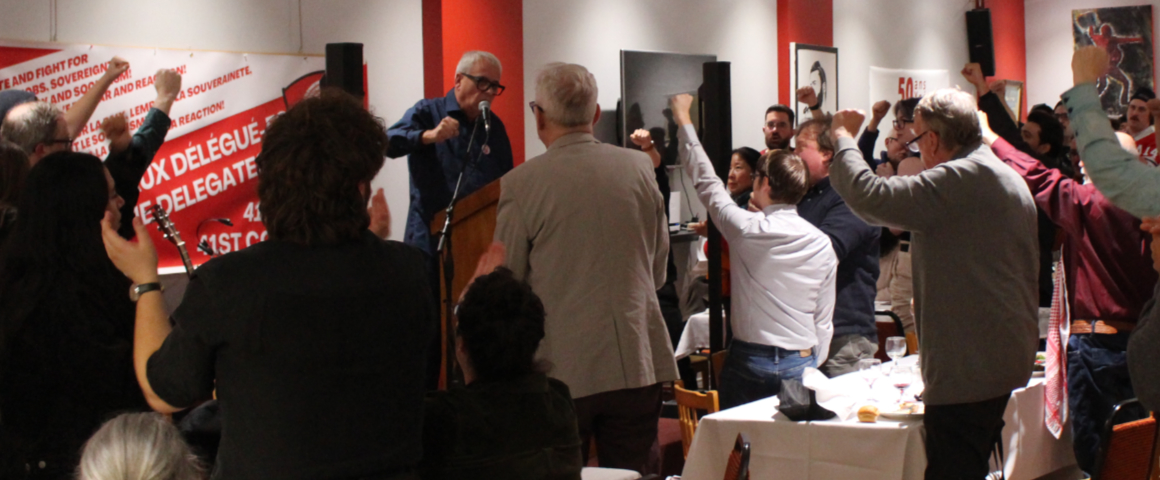By Dave McKee
Ahead of the April 16 federal budget, polling company Ipsos surveyed 1000 people about what their priorities were. The results, published by Global News, indicated some definite trends.
Far and away, with 44 percent of those polled citing it, the number one desire was for Ottawa to help curb the rising cost of living. Among women, 53 percent indicated this was their main priority, as did half of people from Generation X (defined as those born between 1965 and 1980).
While the survey did not dive into what kind of help people wanted from the government, it’s pretty clear that “actions” taken to date – which include facilitating a voluntary grocery corporation code of conduct and cutting back on the number of temporary residents including international students – are utterly insufficient.
No doubt, what survey respondents have in mind are real actions like price controls on basic necessities like food, housing and fuel. Or maybe a big increase in corporate taxes, to redistribute some of those record-breaking profits and help pay for things like childcare and public transit and transportation. What about legislation to roll back rent, so that nobody is compelled to spend more than 20 percent of household income on housing, and solid rent control to cover all tenants and units? Or a real universal pharmacare program that covers all prescription medicine for all people, to help bring down the estimated $46 billion that is spent on medication each year in this country?
Sadly, while those kinds of concrete plans are reflective of people’s number one priority of lowering the cost of living, none was reflected in the budget.
But maybe the feds did better with other parts of the poll? The second-highest priority, selected by 38 percent of respondents, was for increased investment in healthcare. That’s unsurprising, given the decades-long pandemic of underfunding and the resultant understaffing, long wait times, lack of hospital beds, closures of services, inability of 20 percent of people in Canada to secure a family doctor, and expanding privatization of healthcare.
The kind of investment in healthcare that people need is funding that ensures and expands universal, accessible and comprehensive coverage, through public facilities. It’s been proven time and again that procedures performed in private clinics are far more expensive than in public ones. Furthermore, increasingly aggressive upselling is making those procedures less and less accessible to more and more people, and the concentration of privatized and “consolidated” public facilities in urban areas is leaving rural and northern communities with a critical lack of care.
Instead, though, Ottawa continues to focus its funding plan on blanket transfers to provinces with no requirement that the money actually gets spent on public healthcare – Ontario’s Ford government, for example, is literally shovelling public funding into private clinics – while refusing to enforce the Canada Health Act which prohibits now-common practices like user fees and extra billing. When the feds have ponied up for something new – like the recent pharmacare and dental care schemes – they have done so in a way which actively undermines universality by institutionalizing a private system as the main provider, alongside a public system which provides minimal care for a small number of people.
The fourth-highest priority, with a cumulative 32 percent, was for government action on housing. This category includes calls to cool the housing market, build housing and continue the GST rebate for home buyers. Given the duration and breadth of the housing crisis – more than 1.5 million households in Canada are in core housing need, and many more are living in housing they cannot afford – the only surprise is that this was not a higher priority.
But, here again, the government is choosing to stay its course of gimmicky “first-time buyer savings programs” and providing costly publicly funded “incentives” to developers. This decades-old approach is largely responsible for the shape of the current crisis, so why Ottawa believes it will be better this year is a head-shaker.
Instead, the federal government could initiate a federal housing program to build and deliver truly affordable housing. With estimated construction costs of around $160,000 per housing unit (based on the 2024 Canadian Cost Guide), an investment of $32 billion could build 200,000 new housing units. If publicly owned and operated on a non-profit basis, as a public utility and provided according to need, this kind of housing program could yield 1 million homes on a truly affordable, rent-geared-to-income basis, in just five years at a total cost of $160 billion.
So, if Ottawa isn’t putting these kinds of priorities into the budget, what exactly is the government spending money on?
For that, we have to look all the way down towards the bottom of the Ipsos survey. At 11 percent – tied with “I don’t know,” “Some other issue” and “None of the above” – is increasing military spending. And while the government didn’t listen to the higher-placed priorities mentioned above, they answered the call from the military with shocking enthusiasm.
Over the next five years, official military spending in Canada will grow to around $50 billion per year, hitting 1.76 percent of GDP. But, in making that announcement, Justin Trudeau quickly and proudly stated that some elements of the government’s military plan are not yet costed and will need to be added in. “So even as we project we’re heading up to 1.76 percent of GDP in the coming years, we know there is more to come over the coming years, as Canada continues to step up in a more uncertain and, quite frankly, more dangerous world.”
Well, there you have it. The people of the country can complete all the opinion polls and surveys we want, but the government remains determined to prioritize military spending over social need. And they’re using the pretext of unspecified threats to justify that decision.
After all, the central planners of capitalism would have us believe, behind every bedless hospital or exorbitant grocery bill or unaffordable housing unit, there lurks a Russian tank with guns lowered and sighted. You’ll just have to bear a little longer in your cramped apartment with the leaky roof or with your sick relative who can’t afford medication or with the line-up at the food bank, because your country needs to buy another naval destroyer or nuclear-equipped fighter jet.
Communist Party campaigning for cut to arms budget
In this context, with people’s desperate needs displaced by militarism, the Communist Party of Canada is campaigning for a deep cut to the country’s arms budget. Party leader Elizabeth Rowley says that military spending can and should be cut by 75 percent, with those funds redirected to universal public social programs.
Such a reduction would take Ottawa’s projected military budget from $50 billion in 2030 to around $12.5 billion – still enough to defend the country’s borders but none for the NATO wars, funding for “regime change” operations or equipment for atrocities in Palestine, Ukraine or Yemen. Furthermore, the roughly $32 billion saved would pay for the federal housing plan described previously, or any number of other “people’s budget priorities.”
Rowley notes that the process of shifting public funding from services to military has been continuing for a long time. “At the same time that healthcare and other key programs have been starved of funds, between 2014 and 2021 nominal Canadian defense spending grew by 67 percent.”
Clearly, Canada has wealth enough to provide sufficient jobs, housing and services for the people living here. What’s needed is for mass action to force governments to either prioritize people’s needs, or get out of the way and make room for someone who will.
Support socialist media!
If you found this article useful, please consider donating to People’s Voice or purchasing a subscription so that you get every issue of Canada’s leading socialist publication delivered to your door or inbox!
For over 100 years, we have been 100% reader-supported, with no corporate or government funding.




